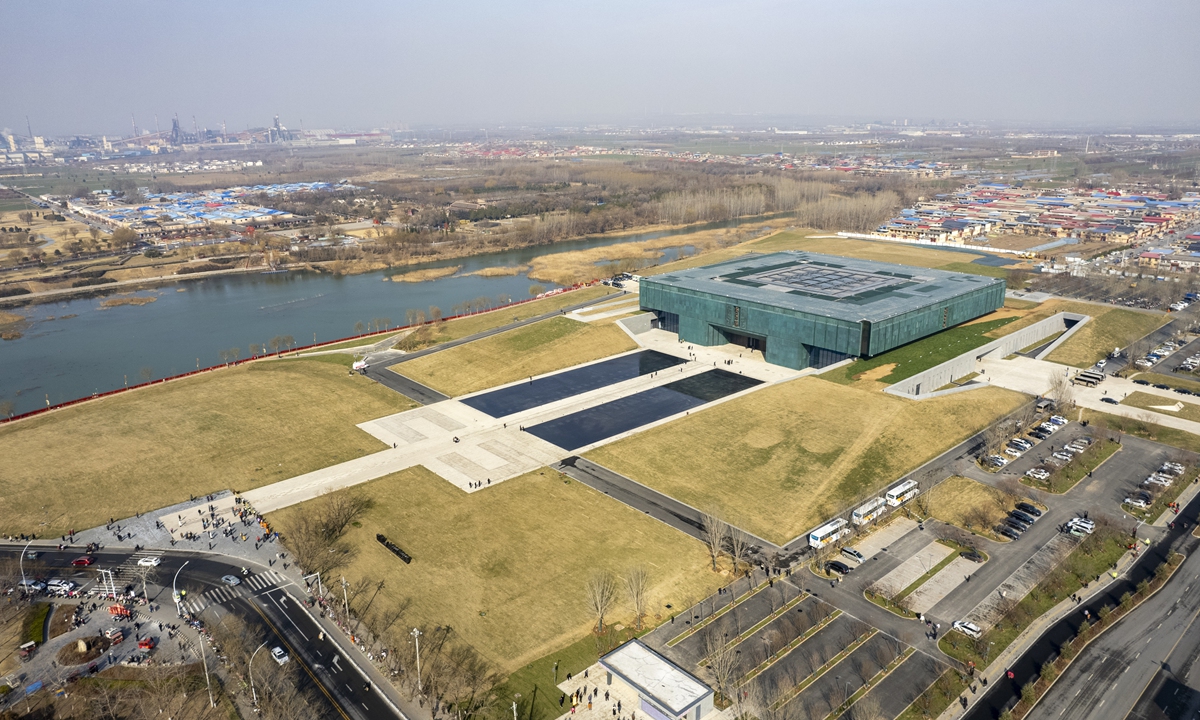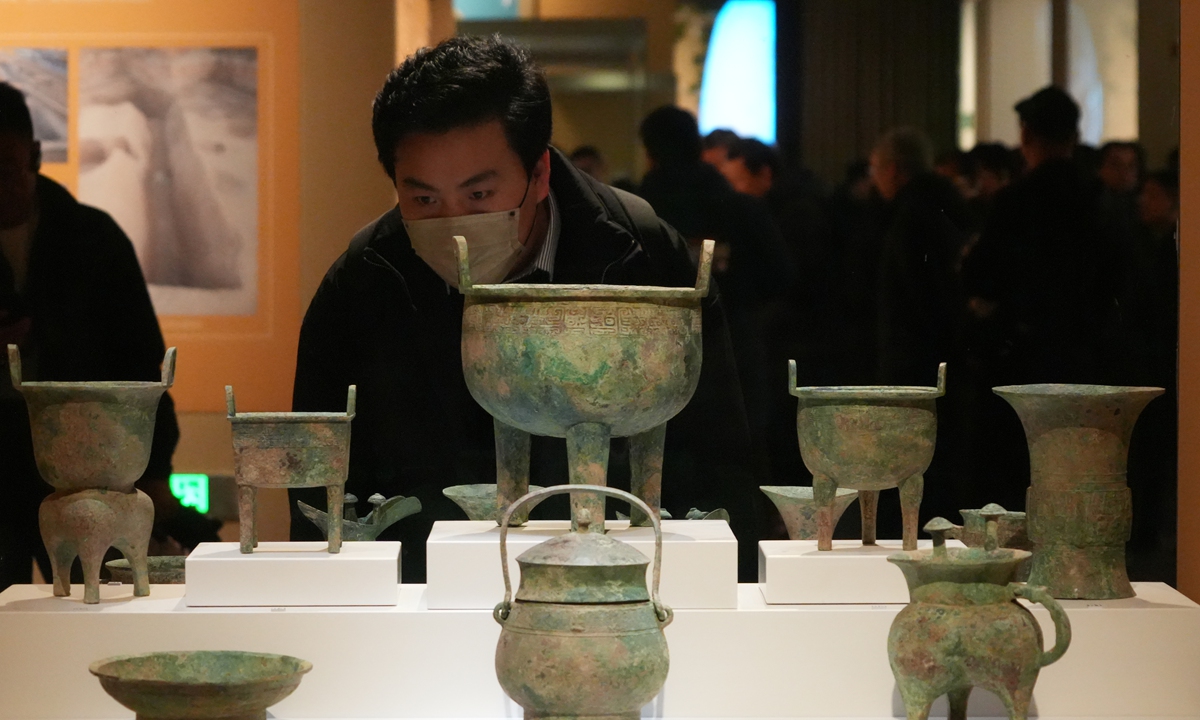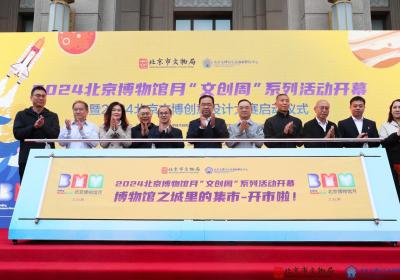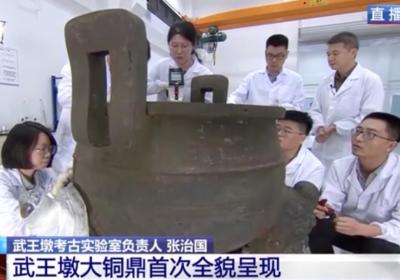
The new building of the Yinxu Museum in Anyang, Henan Province Photo: VCG
Fruitful achievements of nearly a century of archaeological exploration at the world heritage site Yin Ruins are now concentrated in the newly inaugurated building of Yinxu Museum along the banks of the Huanhe River in Anyang, Central China's Henan Province.
The exterior design of the newly constructed museum building draws inspiration from the Shang Song in the Book of Songs, featuring green grass platforms, towering bronze sculptures, and layered depths, all enveloped in bronze color.
Many visitors have expressed their admiration for the dignified and atmospheric design of the museum, with its distinctive bronze-colored walls evoking a feeling of retro time travel back to the grand Shang Dynasty (c.1600BC-1046BC).
Artifact highlights The new Yinxu Museum building houses approximately 22,000 square meters of exhibition halls, displaying nearly 4,000 sets of artifacts including bronzeware, pottery, jade artifacts, oracle bones, and more. The vast quantity and diverse types of exhibited artifacts represent the pinnacle of Shang Dynasty artifact exhibitions. Among them, over three-quarters of precious artifacts are making their public debut, showcasing a series of new archaeological achievements.
One particularly eye-catching exhibit at the new building is the display of 23 out of hundreds of chariots excavated from the Yin Ruins, with the majority being two-horse chariots, marking the first large-scale exhibition of chariots in China.
He Yuling, deputy director of the Anyang workstation of the Institute of Archaeology, the Chinese Academy of Social Sciences (CASS), explained that what visitors see might seem like a pile of earth, but archaeologists painstakingly revealed the decaying wood grain, gradually restoring them to as near original condition as possible. Therefore, the cleaning of chariots and horse pits has always been a remarkable skill displayed by Chinese archaeologists.
A docent at the museum told the Global Times that the Shang civilization excelled in many aspects globally. Apart from the unearthed chariots, their advancements in bronze casting were also remarkable.
One of the most astonishing artifacts is the "most luxurious oracle bone," the only existing oracle bone in Chinese museums with a turquoise inlay. It records when a Shang king inspects military hunting activities. The exquisite turquoise inlay within the inscription not only showcases the authority of the Shang king but also adds exquisite beauty to the entire oracle bone.
Another eye-catching artifact is the mysterious bronze hand-shaped artifact that exhibits lifelike details, with proportional fingers, clear joints, smooth fingertips, and a back decorated with exquisite animal face patterns. Whether it served as a scepter or a prosthetic limb remains uncertain.
Many visitors wonder about the appearance of ancient people in the Shang Dynasty. A pottery figure portraying wide, flat foreheads, thick eyebrows, deep-set eyes, broad noses, and thick lips seems to provide valuable clues...

Visitors explore an exhibition at the new building of the Yinxu Museum in Anyang, Henan Province. Photo: VCG
Hi-tech exhibition The new building features three basic exhibitions focusing on the Shang civilization, with four thematic exhibitions and one distinctive immersive digital exhibition. The immersive digital exhibition fully utilizes technologies such as artificial intelligence and multimedia resources to present artifacts, documents, and oracle bone inscriptions in innovative ways.
Yan Guojun from the Tencent Sustainable Social Value Organization Digital Culture Lab told the Global Times that in the special oracle bone exhibition on the third floor of the new museum building, 16 physical oracle bones are displayed synchronously with high-definition projection screens and interactive small screens, exploring the inscriptions on oracle bones in a comprehensive digital manner.
By using the latest imaging technologies such as high-precision 3D oracle bone models, high-definition images, and enhanced micro-trace images, the front and back images of each oracle bone are aligned, allowing viewers to delve into the cultural information contained in each oracle bone.
At the core of the exhibition, visitors can easily locate interactive exhibits corresponding to the physical oracle bones. While experiencing interactive activities on small screens, the huge screens above the exhibit installations will synchronize real-time interactive effects, showcasing the exhibition to other visitors.
Through one screen, visitors can gain an in-depth understanding of the cultural connotations contained in these oracle bones through high-precision 3D oracle bone models and visualized oracle bone inscription information.
According to Yan, the Tencent Sustainable Social Value Organization Digital Culture Lab and the Anyang Oracle Bone Information Processing Lab have collaborated for many years, primarily providing support in artificial intelligence and other technologies to help archaeologists improve the efficiency of deciphering oracle bone inscriptions.
As the birthplace of oracle bone inscriptions, the earliest known Chinese writing, the Yin Ruins has unearthed tens of thousands of oracle bones. Some oracle bones were used in divination by members of the imperial family in the Shang Dynasty, and some oracle bone inscriptions record the romantic sentiments of ancient Chinese people. For example, many oracle bone inscriptions unearthed from Yin Ruins record divinations made by Wu Ding, a Shang Dynasty king for his wife, Fu Hao, after her death, expressing his concern for her well-being in the afterlife. This unveils the romantic relationship between King Wu Ding and Fu Hao over 3,000 years ago.
Zhao Qingrong, deputy director of the Yinxu Museum, told the Global Times that the new museum is currently tasked with collecting and digitizing oracle bone inscriptions scattered across China and the rest of the world. It will become the largest database showcasing the digitized achievements of oracle bone inscriptions.
Significance of Shang civilization Many experts have emphasized that Yin Xu is a spiritual symbol of the Chinese nation, acclaimed as the "cradle of modern Chinese archaeology."
Chen Xingcan, director of the Yinxu Museum, told the Global Times that Yinxu, as the first historical capital site of the late Shang Dynasty with documented literature and verified by archaeological excavations, holds undeniable importance in the world of archaeology. It can be said that the Shang civilization, represented by Yin Ruins, is an important part of Chinese origin tracing and the first highly developed civilization in East Asia.
On the third floor of the exhibition hall is an exhibition on the Shang civilization artifacts around the world, which details the precious artifacts from the Shang period that have been lost overseas, including bronzeware, oracle bone inscriptions, and more.
Tang Jigen, one of the exhibition planners and a research fellow at the Institute of Archaeology, CASS, told the Global Times that many overseas museums have strongly supported the construction of the museum. They have provided images and detailed materials of their bronzeware collections to meet the needs of the exhibition.
"These museums and archaeologists are very interested in China's latest progress and research on the Yin Ruins and the Shang civilization, and are eager for more opportunities for exchanges," he said.







